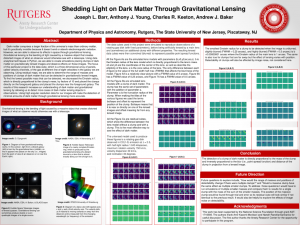Barr, Joseph: Shedding Light on Dark Matter Through Gravitational Lensing

Title: Shedding Light on Dark Matter Through Gravitational Lensing.
Name: Joseph Barr
Major: Computer Engineering
School affiliation: School of Engineering
Programs: Aresty Summer Science Program
Other contributors: Andrew J. Baker, Charles R. Keeton, Anthony J. Young
Abstract: Dark matter comprises a larger fraction of the universe’s mass than ordinary matter, but it’s practically invisible because it doesn’t emit or absorb electromagnetic radiation. However, we are able to observe its effects in space through gravitational lensing. Gravitational lensing is the bending of light caused by a massive object that creates distorted images of what an observer would otherwise see with a telescope. Using data analytical techniques in Python, we are able to create simulations placing clumps of dark matter on gravitationally lensed images and observe effects on those images. The focus of this particular project is the data cube, which is a three dimensional array of panels, called velocity channels, of the gas at different line of sight velocities in the galaxy we are observing. Using residual maps, we are able to determine the range of masses and positions of clumps of dark matter that can be detected in gravitationally lensed images. To find the lowest possible mass that can be detected, we decreased the Einstein radius, which is directly proportional to the clump’s mass, by factors of 10 and placed the clumps directly on the foreground galaxy and placed the clumps near the foreground galaxy. The results of this research increase our understanding of dark matter and gravitational lensing by allowing us to detect more cases of dark matter lensing objects in observations. Using high angular resolution data for our images will make the detection of minimal amounts of dark matter through gravitational lensing more accurate.